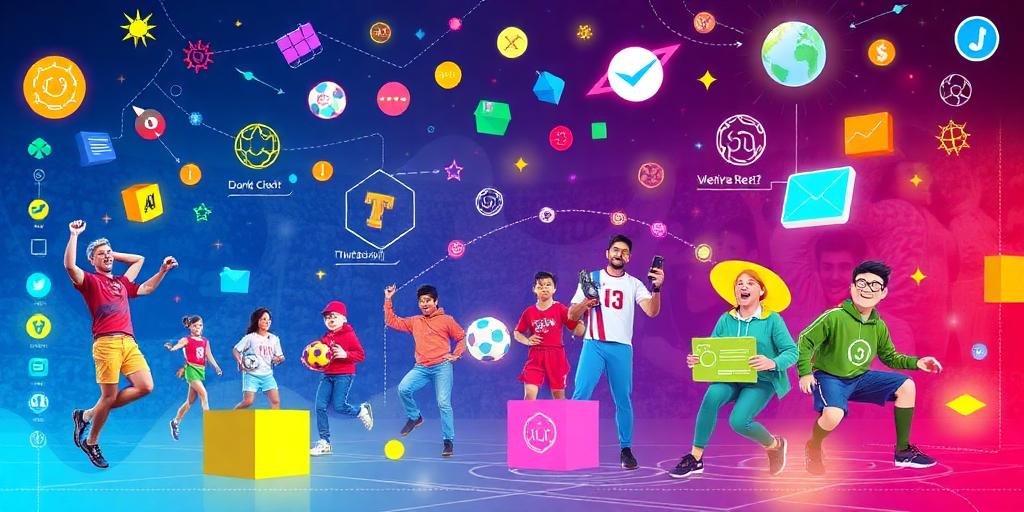Gamification in Fan Engagement Strategies (2025)
Gamification, the integration of game-design elements and game principles in non-game contexts, is rapidly transforming fan engagement strategies across various sectors. By 2025, its applications are projected to become even more sophisticated and integral to fostering stronger connections between organizations and their audiences.
Understanding Gamification
At its core, gamification leverages human psychology to motivate and engage individuals. Points, badges, leaderboards, challenges, and rewards are common elements used to drive participation and create a sense of achievement. When applied thoughtfully, gamification can increase user engagement, loyalty, and overall satisfaction.
Current Trends Shaping Gamification in 2025
Several key trends are shaping the future of gamification in fan engagement:
-
Personalization: Gamification strategies are becoming more personalized, leveraging data analytics to tailor experiences to individual preferences and behaviors. This ensures that challenges and rewards resonate with each fan, maximizing engagement.
-
Mobile Integration: With the proliferation of smartphones, mobile gamification is a cornerstone of fan engagement. Mobile apps and platforms provide seamless access to gamified experiences, allowing fans to participate anytime, anywhere.
-
Social Gamification: Integrating social elements, such as sharing achievements on social media and competing with friends, enhances the sense of community and encourages viral growth.
-
Augmented Reality (AR) and Virtual Reality (VR): AR and VR technologies are creating immersive gamified experiences, offering fans unique and interactive ways to engage with their favorite brands or teams. Imagine attending a virtual concert where you earn points for participating in challenges or unlocking exclusive content through AR scavenger hunts.
-
Data Analytics and AI: Advanced data analytics and artificial intelligence (AI) are enabling organizations to gain deeper insights into fan behavior and optimize gamification strategies in real-time. AI algorithms can predict which challenges and rewards will be most effective, ensuring continuous improvement and relevance.
Applications Across Industries
Gamification is being applied across a wide range of industries to enhance fan engagement:
- Sports: Sports teams are using gamification to reward fan loyalty, encourage attendance, and boost merchandise sales. Examples include fantasy leagues, virtual rewards for attending games, and challenges to predict game outcomes.
- Entertainment: Movie studios, music labels, and entertainment companies are leveraging gamification to promote new releases and build fan communities. Interactive trailers, virtual concerts, and social media challenges are common tactics.
- Retail: Retailers are using gamification to drive customer loyalty, increase sales, and gather valuable customer data. Loyalty programs with tiered rewards, virtual challenges, and personalized offers are popular strategies.
- Education: Educational institutions are integrating gamification to make learning more engaging and effective. Points, badges, and leaderboards are used to motivate students and track progress.
Best Practices for Implementing Gamification
To ensure the success of gamification in fan engagement, consider the following best practices:
- Define Clear Objectives: Identify the specific goals you want to achieve with gamification, such as increasing fan loyalty, boosting attendance, or driving sales.
- Understand Your Audience: Tailor gamification strategies to the preferences and behaviors of your target audience. What motivates them? What rewards do they value?
- Keep It Simple: Avoid overly complex game mechanics that can confuse or frustrate fans. Focus on creating a seamless and intuitive experience.
- Provide Meaningful Rewards: Ensure that rewards are relevant and valuable to fans. This could include exclusive content, discounts, VIP access, or recognition.
- Continuously Monitor and Optimize: Track the performance of your gamification strategies and make adjustments as needed. Use data analytics to identify what’s working and what’s not.
Challenges and Considerations
Despite its potential, gamification is not without its challenges:
- Over-Reliance on Extrinsic Motivation: Relying too heavily on external rewards can undermine intrinsic motivation and lead to decreased engagement over time.
- Sustainability: Maintaining long-term engagement requires continuous innovation and fresh content. Stale or repetitive gamification strategies can quickly lose their appeal.
- Ethical Concerns: Ensure that gamification strategies are transparent and fair. Avoid manipulative tactics that could damage trust and alienate fans.
The Future of Fan Engagement
As we move closer to 2025, gamification will continue to evolve and play a critical role in fan engagement strategies. Organizations that embrace personalization, mobile integration, and data analytics will be best positioned to create meaningful and lasting connections with their audiences.
By understanding the trends, applications, and best practices of gamification, businesses can harness its power to build stronger fan communities, drive loyalty, and achieve their strategic objectives. The key is to create experiences that are not only engaging but also valuable and rewarding for fans.
